Birdfinding.info ⇒ The southeastern form of Village Weaver is locally common in eastern South Africa, especially KwaZulu-Natal, including the vicinity of Durban. Near Johannesburg, Rietvlei Nature Reserve is a consistent site. Often seen on visits to Kruger National Park and the nearby game reserves. Introduced populations on Réunion and Mauritius are locally numerous along the coasts and in Black River Gorges National Park.
“Spot-backed Weaver”
Textor cucullatus spilonotus
Family: Ploceidae
Southeastern Africa. Inhabits various open, semiopen, and edge habitats, including marshes and human settlements.

Approximate distribution of the forms of Village Weaver. © BirdLife International 2018
Resident in the savanna zone of eastern South Africa and adjacent countries: from southeastern Botswana and southernmost Zimbabwe east across the southern portion of Mozambique (north to the Save River), south through Eswatini and KwaZulu-Natal, then in coastal lowlands to Eastern Cape Province.
Sparse or sporadic farther west in the drier grasslands of central South Africa and the highlands of Lesotho.
Breeds colonially in trees and reedbeds. The nest is a woven mass suspended from a branch or reed, entered from below. Also roosts colonially, often in palm trees.
Introduced populations are established on Mauritius and Réunion.
Identification
Like other forms of Village Weaver: a large, stocky, heavy-billed weaver with vivid red eyes, that is often found in agricultural and settled areas. The breeding male differs from other forms in its yellow crown and spotted back.

“Spot-backed Weaver”, T. c. spilonotus, male in breeding plumage. (Scottburgh, KwaZulu-Natal, South Africa; December 12, 2013.) © Peter Vos
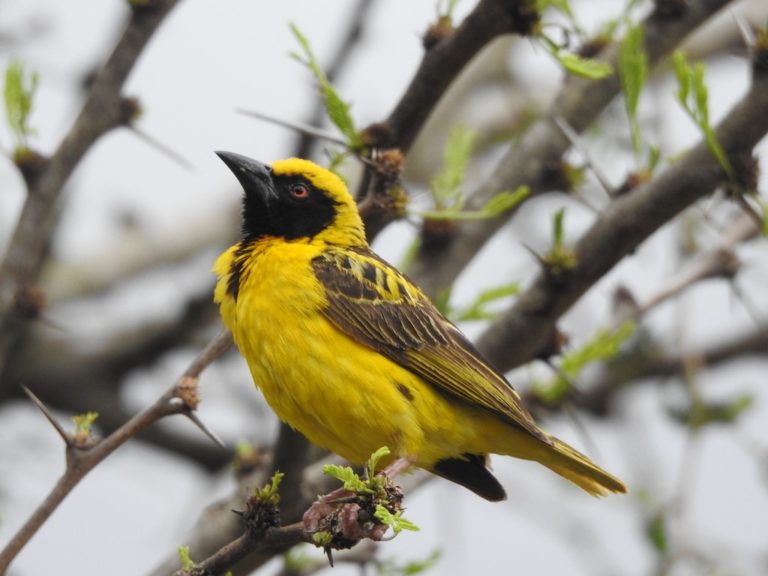
“Spot-backed Weaver”, T. c. spilonotus, male in breeding plumage. (North Uthungulu, KwaZulu-Natal, South Africa; February 1, 2019.) © heliastes21
Males in breeding plumage are bright-yellow overall, with a black mask and throat that typically extends down as a narrow bib. The entire crown, including the forehead, is yellow, and the back is yellow with black streaks or spots.
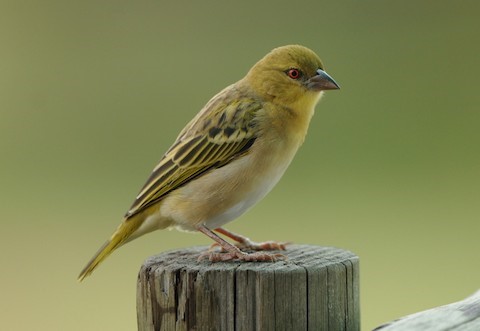
“Spot-backed Weaver”, T. c. spilonotus, basic plumage. (Pilanesberg National Park, North-West, South Africa; April 9, 2011.) © Gareth Preiss

“Spot-backed Weaver”, T. c. spilonotus, basic plumage. (eThekwini, KwaZulu-Natal, South Africa; July 2018.) © Gareth Preiss
As in other forms of Village Weaver, females, immatures, and nonbreeding males are comparatively drab and nondescript, but variable—often best recognized by their large bills and red eyes.

“Spot-backed Weaver”, T. c. spilonotus, basic plumage. (Umgungundlovu, KwaZulu-Natal, South Africa; November 16, 2020.) © Shaun Swanepoel
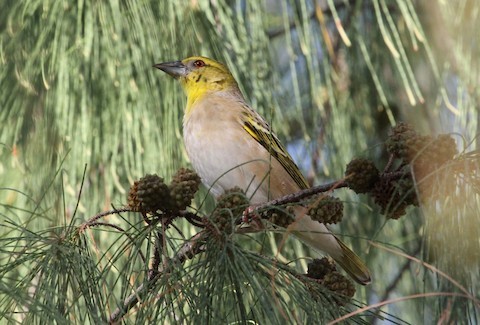
“Spot-backed Weaver”, T. c. spilonotus, basic plumage. (Flic en Flac, Black River, Mauritius; June 22, 2017.) © Paul Lewis
They can be either olive or grayish overall, variably suffused with pale lemon yellow, mainly on the head, throat, and wings—often with a distinct yellow brow.
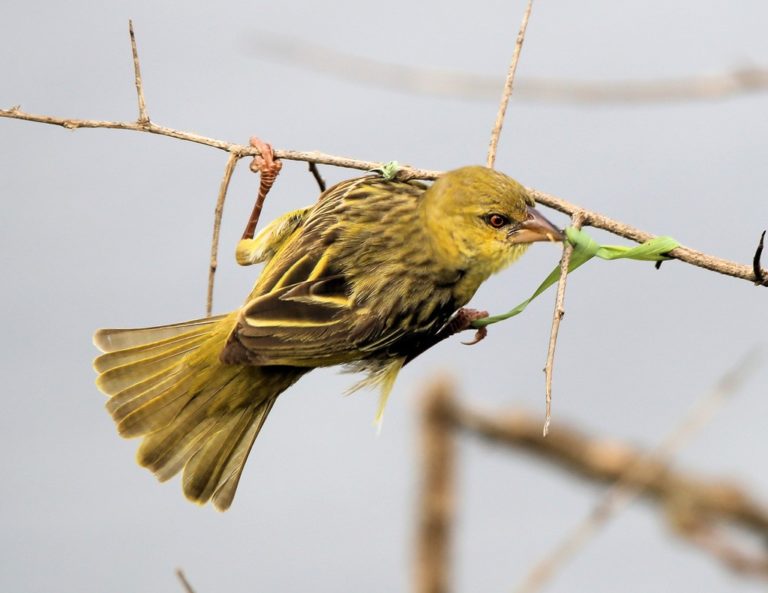
“Spot-backed Weaver”, T. c. spilonotus, basic plumage. (Kruger National Park, South Africa; January 29, 2018.) © martizasouthafrica
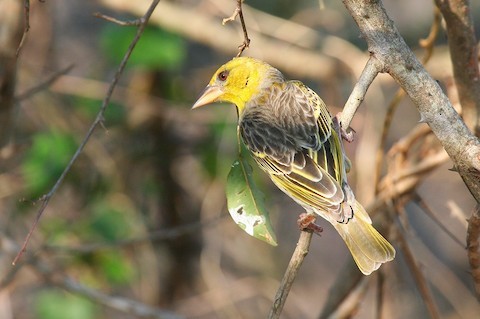
“Spot-backed Weaver”, T. c. spilonotus, basic plumage. (Howick, Kwazulu-Natal, South Africa; August 18, 2012.) © Don-Jean Léandri-Breton
Notes
Monotypic form, one of four or five potentially distinct forms of Village Weaver (cucullatus).
See below for a comparison of the “Spot-backed Weaver” with the Southern Masked Weaver.
Cf. Southern Masked Weaver. The breeding male “Spot-backed Weaver” is most likely to be confused with Southern Masked Weaver, which occurs throughout its range and shares its basic coloration, head pattern, red eyes, and streaked back. The most objective difference between them is the forehead: on Southern Masked the black extends onto the forehead, whereas “Spot-backed” has a yellow forehead. They also differ in size (Southern Masked is somewhat smaller) and the coloration and pattern on their backs: Southern Masked’s back is greenish with fine dark streaks, lacking the strongly contrasting yellow-and-black on “Spot-backed”.
More Images of the “Spot-backed Weaver”
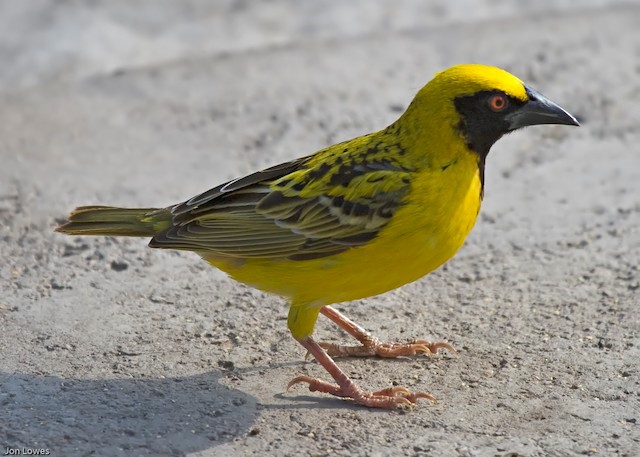
“Spot-backed Weaver”, T. c. spilonotus, male. (Mopani, Limpopo, South Africa; October 20, 2009.) © Jon Lowes

“Spot-backed Weaver”, T. c. spilonotus, male. (Lower Sabie, Mpumalanga, South Africa; October 27, 2009.) © Jon Lowes

“Spot-backed Weaver”, T. c. spilonotus, breeding male. (Sappi Stanger, Kwazulu-Natal, South Africa; October 27, 2016.) © Brad Arthur
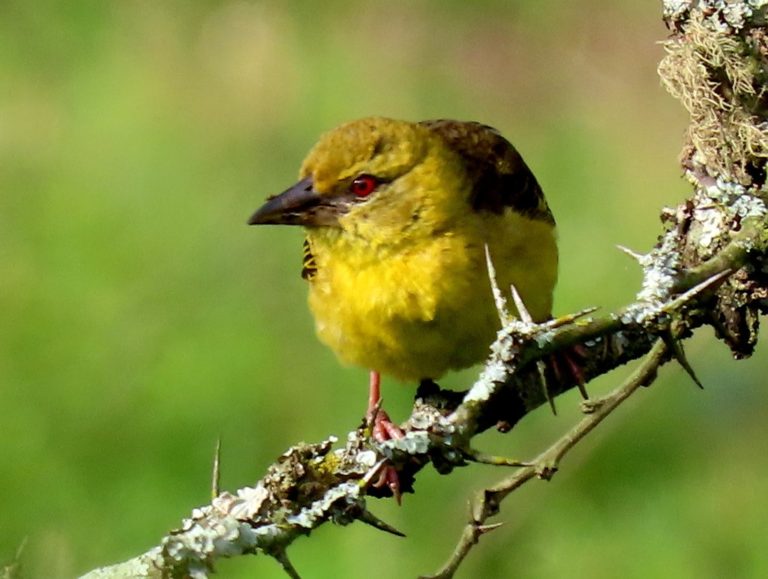
“Spot-backed Weaver”, T. c. spilonotus, basic plumage. (Cumberland Nature Reserve, KwaZulu-Natal, South Africa; November 27, 2021.) © Gigi Laidler

“Spot-backed Weaver”, T. c. spilonotus, basic plumage. (Mkhuze Game Reserve, KwaZulu-Natal, South Africa; November 25, 2017.) © Simon Tonge
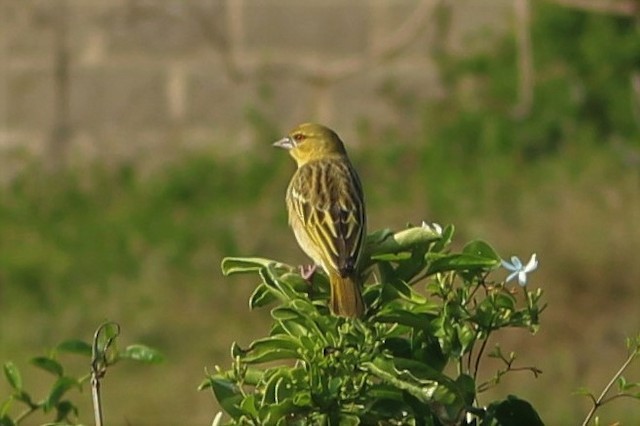
“Spot-backed Weaver”, T. c. spilonotus, basic plumage. (Tofo, Inhambane, Mozambique; May 28, 2017.) © Bryce Loschen

“Spot-backed Weaver”, T. c. spilonotus, male at nest. (Mlilwane Wildlife Sanctuary, Manzini, Eswatini; October 11, 2007.) © Bruce Robinson

“Spot-backed Weaver”, T. c. spilonotus, colony. (Mopani, Limpopo, South Africa; December 11, 2013.) © Wynand Uys
References
BirdLife International. 2018. Ploceus cucullatus. The IUCN Red List of Threatened Species 2018: e.T22718921A132122615. https://dx.doi.org/10.2305/IUCN.UK.2018-2.RLTS.T22718921A132122615.en. (Accessed April 22, 2022.)
eBird. 2022. eBird: An online database of bird distribution and abundance. Cornell Lab of Ornithology, Ithaca, N.Y. http://www.ebird.org. (Accessed April 22, 2022.)
Sinclair, I., and P. Ryan. 2003. Birds of Africa South of the Sahara. Princeton University Press.
Sinclair, I., P. Hockey, W. Tarboton, and P. Ryan. 2011. Birds of Southern Africa (Fourth Edition). Random House Struik (Pty) Ltd. Cape Town, South Africa.
van Perlo, B. 1999. Birds of Southern Africa. Princeton University Press, Princeton, N.J.
Xeno-Canto. 2022. Village Weaver – Ploceus cucullatus. https://xeno-canto.org/species/Ploceus-cucullatus. (Accessed April 22, 2022.)
